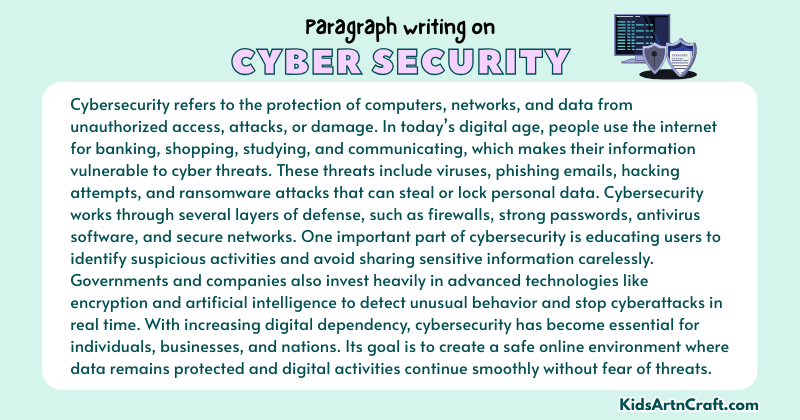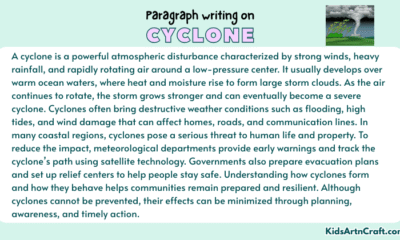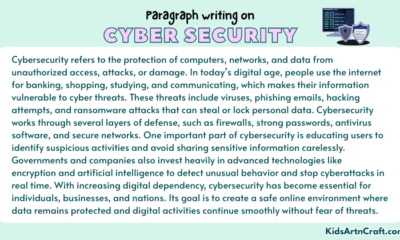Paragraph Writing
Paragraph on Cyber Security
Cybersecurity protects computers, data, and online activities from hackers and threats. This paragraph explains the importance of online safety, digital protection, and secure internet practices. This activity focuses on learning how to write about a “Cyber Security” in multiple paragraph styles—Expository, Persuasive, Descriptive, and Narrative—while following PEEL, TEEL, TEXAS, and the Hamburger structures.
Most of our paragraphs are in 150 to 200 words. You can also find longer paragraphs (in 300 words) on ‘Cyber Security’ or essays on the same topic on the web.
Different Styles of Paragraphs on ‘Cyber Security’
1. Expository Paragraph on Cyber Security (Explains with Facts)

Cybersecurity refers to the protection of computers, networks, and data from unauthorized access, attacks, or damage. In today’s digital age, people use the internet for banking, shopping, studying, and communicating, which makes their information vulnerable to cyber threats. These threats include viruses, phishing emails, hacking attempts, and ransomware attacks that can steal or lock personal data. Cybersecurity works through several layers of defense, such as firewalls, strong passwords, antivirus software, and secure networks. One important part of cybersecurity is educating users to identify suspicious activities and avoid sharing sensitive information carelessly. Governments and companies also invest heavily in advanced technologies like encryption and artificial intelligence to detect unusual behavior and stop cyberattacks in real time. With increasing digital dependency, cybersecurity has become essential for individuals, businesses, and nations. Its goal is to create a safe online environment where data remains protected, and digital activities continue smoothly without fear of threats.
2. Persuasive Paragraph on Cyber Security (Tries to Convince You)
Cybersecurity is no longer optional; it is a necessity that every individual and organization must take seriously. With the rise of online banking, digital payments, and social media, our personal information is constantly at risk. Hackers are becoming smarter each day, and one careless click can expose private data or cause financial loss. This is why everyone must follow cyber-safe habits such as using strong passwords, enabling two-factor authentication, and updating software regularly. Schools and workplaces should also include cybersecurity training so people can recognize phishing attempts or unsafe websites. Companies must invest in modern security systems, not just to protect themselves but also to safeguard their customers’ data. Ignoring cybersecurity can lead to identity theft, data breaches, and even national-level threats. By adopting responsible online behavior and supporting strong security measures, we can create a safer digital world. It is time for all of us to take action and make cybersecurity a priority.
3. Descriptive Paragraph on Cyber Security (Paints a Picture with Words)
Cybersecurity resembles an invisible shield that surrounds every digital device we use. It feels like a silent guard standing watch over our phones, computers, and online accounts, protecting them from hidden dangers that lurk on the internet. Behind every login screen, layers of security quietly work in the background—firewalls block suspicious traffic, antivirus programs scan for harmful files, and encryption locks our data like a secret code. The digital world may appear bright and convenient, but beneath its surface lies a maze of threats waiting to strike. Cybersecurity creates a sense of safety, allowing us to browse, work, and communicate without fear. It transforms a chaotic online space into a controlled environment where information flows smoothly. Just like a security guard at a gate, cybersecurity checks every entry and ensures only trusted users can pass. Its presence may be unseen, but its protection shapes the entire digital experience.
4. Narrative Paragraph on Cyber Security (Tells a Story)
Last year, Rohan experienced a frightening moment that taught him the true value of cybersecurity. One morning, he opened an email that looked like a message from his bank. Without thinking, he clicked the link and entered his details. Within minutes, he received alerts about unauthorized transactions. Panicked, he called the bank, only to learn he had fallen into a phishing trap. Fortunately, the bank’s cyber security team acted quickly, froze his account, and recovered the lost amount. They advised him to change his passwords and activate two-factor authentication. Rohan realized how easily someone could be tricked online. He attended a cyber safety workshop and learned how to identify suspicious links and secure his devices. Now, he regularly updates his software, uses strong passwords, and warns his friends about online scams. His experience taught him that cybersecurity is not just a technical term—it is a daily habit that protects us from digital dangers.
‘Cyber Security‘ Paragraphs in Different Structured Methods
1. Cyber Security Paragraph Writing with PEEL Method
PEEL Method (Point, Evidence, Explanation, Link)

Point: Cybersecurity is important because it keeps our online information safe.
Evidence: For example, if someone shares their password or clicks on a fake link, a hacker can enter their account and misuse it.
Explanation: When we use the internet for games, studies, or chatting, our data can be seen by others if we are not careful.
Link: That’s why children must follow simple safety rules like using strong passwords, avoiding strange links, and never sharing personal details online. These habits keep us safe and confident while using the internet.
2. Cyber Security Paragraph Writing with TEEL Method
TEEL Method (Topic, Evidence, Explanation, Link)
Topic: Cybersecurity helps protect children from online dangers.
Evidence: Studies show that most online attacks happen because users click unsafe links or share private information without checking. Children who learn cyber safety become smarter internet users.
Explanation: Many websites and apps collect information, and sometimes hackers try to steal it.
Link: By remembering small rules such as not talking to strangers online, keeping passwords secret, and asking adults for help when unsure, kids can stay safe and enjoy the internet without fear.
3. Cyber Security Paragraph Writing with the TEXAS Method
TEXAS Method (Topic, Example, Explanation, Analysis, Summary/Significance)
Topic: Cybersecurity teaches kids how to stay safe online.
Example: For instance, a child might receive a message offering free rewards. If they click it, a virus may enter the device.
Explanation: The internet has games, videos, and learning tools, but it also has risks like fake messages and harmful websites.
Analysis: This shows why it is important to think before clicking anything online. Cybersecurity rules guide kids to behave safely and protect their information.
Summary: When children follow these rules, they can use the internet wisely and enjoy it securely.
4. Cyber Security Paragraph Writing with Hamburger Method
Hamburger Method (Top Bun, The Fillings, Bottom Bun)

Top Bun (Topic Sentence):
Cybersecurity helps kids stay safe while using the internet.
The Fillings (Supporting Details):
Children often use devices for studying and entertainment, but online threats like fake links, viruses, and strangers can cause trouble. To stay safe, kids must use strong passwords, avoid sharing personal information, and tell a trusted adult if something feels wrong. They should also avoid clicking on unknown pop-ups or messages. These simple steps act like a safety shield around their online activities.
Bottom Bun (Concluding Sentence):
By learning and following cybersecurity rules, kids can explore the internet safely and confidently.
Hope you liked these paragraphs on ‘Cyber Security’. Don’t forget to join the Telegram group for FREE Printables.













